Original Project proposal:
Our activity is the creation of a darkly humorous interactive performance. We want to achieve:
A piece in which the dramaturgy is inextricable from the technicalities of audience participation. We aim to destabilise reality and to prompt a mystical psychedelic experience.
We ask:
- What is immersive theatre and how do you make it?
- What is the place of discomfort in interactive theatre?
- What is the place of destabilising humour in interactive theatre?
- How can the betrayal of trust be used as a tool in interactive theatre?
We will return to and expand upon the processes shared by guest practitioners during the practices unit, such as Gemma Brockis’ table improv exercise, Ada Mukhina’s collaboration fears exercise, and Clusterflux’s adaptation exercise. We will explore theatre-adjacent practices such as escape rooms, museums, video games, and role playing games. We will each bring in research material related to our own personal interests for inspiration and adaptation.
The First Rehearsal
For the first exercise we did as a company, each person drew a card with a role on it and then had to give a tour of the New Studio in character. Jack was an estate agent, Domi was an alien, Hannah was a medium and Anna was a forensic scientist. We each had to turn the space into something new using only the power of storytelling. From the exercise we learnt:
“The closer to reality, the more likely an audience member will participate, or the more comfortable/familiar an audience member is with the situation, the more likely they will participate” (Rehearsal Notes, 2022),
which helped us move forward when thinking about what kind of scenarios would be most effective when experimenting with participation. We also brought in research material that we wanted to incorporate into the work. Some of the material included:
1. Fallible operation of nuclear missiles
2. Surrealism (Including Leanora Carrington stories, the SCP Foundation, The Weird and The Eerie by Mark Fisher, Proto-Indo-European Mythology and discussions about cracks in reality)
3. Bertolt Brecht’s V-Effect
4. Multisensory diegesis (A term we made up to describe when you use storytelling to trigger a sensory experience that only exists in the imagination of the receiving audience not in reality)
These research materials provided a baseline that mixed ideas of distorting reality and world building, as well as slight nods to capitalism and institutions. This research gave us a shared language from the start of the process.
A key stimulus that appeared in our first rehearsal was an image we would refer to as "Cucumber Man".
"Cucumber Man"
This image gave us a strong textural feeling and led us to explore sensory experiences and removal of sight. We were interested in what multi-sensory diegesis meant to us and how we could use it in our work to distort reality. The first fragment made in response to this image was made by Jack and Hannah. They laid Domi and Anna down, covered their eyes with a scarf, played ocean sounds and dabbed them with wet toilet paper. We saw how engaging another sense without sight can trick your mind into imagining you are being touched by wet cucumber even when you know in reality it is wet toilet paper.This started our deeper exploration into our term multi-sensory diegesis. This fragment fed into our first sharing.
The Second Rehearsal
We paired up to create two separate fragments that explored themes from the previous rehearsal, such as cracks in reality, multi-sensory diegesis, and ‘small action, big consequence.’ We also started exploring strange loops and audio.
We then creatively responded to each other's fragments adding the prompt “create an audio recording, which should be a set of instructions or an ‘experience’ for the other pair.” We discovered ways to construct conflicting narratives for two audience participants. We gave them each a different story that was bridged by the same sensory experience, but represented something different in the two narratives. What we found most interesting in these fragments was creating a ‘rug pull’ moment, where one person’s instructions conflicted with the other, causing a clash of narrative and a reveal of the opposing stories. We decided to further develop the Cucumber Man fragment to explore this technique.
Rug Pull Experiment Fragment
The First Sharing
We aimed to continue exploring multi-sensory diegesis, participation and rug pull moments for the first sharing. We took the idea of bridging narratives through a sensory experience, which is why we separated the audience into two groups and gave them different narratives. The group outside was given a pot of water, tissue and instructions on how to care for victims of a school bus crash whilst the group in the New Studio were listening to an audio through headphones about a peaceful walk in the forest disrupted by an encounter with a bear. The sensory experience of wet tissue on the skin became representative of two very different narratives - caring for wounded children and being licked by a bear.
Masked Violence
In our 5th rehearsal we drew inspiration from two short stories: The Rabbits by Leonora Carrington and The Mimic by Donald Wollheim. We also watched the Winkie’s Scene from Mulholland Drive by David Lynch. We created a series of strange, alien-like characters through quick creative responses using props for each fragment. After spending a few rehearsals exploring these strange characters and darker narratives, we settled on the prompt ‘Masked Violence’ for further rehearsals. We leaned into the idea of fantasy and reality being placed side by side and the idea of luring participants into something that seems transcendent of daily life.
Masked Violence Fragment
Masked Violence Fragment
The Creatures Come to Life
In our tenth rehearsal, we watched a video about aggressive mimicry in jumping spiders. We then received a random prop and did some free-writing in the form of a wikipedia-style entry. We had to invent a mimicking predator who uses the prop we’d been given as its means of hunting. We described tactics, preferred environment and preferred prey. We then made fragments in which we played the mimic, using the prop, and an audience participant played the prey. This led to the creation of two characters we called Rain Creature (who used an umbrella) and Fan Creature (who used an office fan).
Domi, as the rain creature, disguised herself as a commuter, hunting those on their way home after a late night at the office. The participants received the following text before entering the space: ‘It’s another rainy evening and you’re on your way home from work. Visibility is low this time of night so you need to stick to the path. Follow the cables along the floor and keep walking’. When they entered the space there was a large circle made from cables. On the other side of the circle was the ‘Rain Creature’ who wore a long black coat, blue sunglasses and held an umbrella. The creature started walking once the participant started to walk the circle. The creature would gradually pick up speed until they were right behind the participant. It would eventually link arms with them, take them under the umbrella and then in a quick swoop lead them off the path and into another room. This fragment stuck with us because it combined elements of the familiar and mundane commute home from work with a fantastical world. The fragment also created an aesthetic that we wanted to develop further.
The fan creature, on the other hand, lured their prey with the promise of cool air. When the prey was distracted by the strange fan, Hannah would jump out and blindfold them with a jumper. However, Hannah’s attempt to ‘catch’ her prey failed, as the participants didn’t take notice of the fan and kept walking. We developed the fragment further with the prompt “include either multiple endings depending on the actions of the participant, or an element by which the participant must use their own mimicry to survive the encounter.”
In this version, there was a single spotlight on the fan in the darkened studio space. The fan was running. The participant approached the fan and after a moment heard a voice calling out through a speaker. The voice asked the participant a series of 3 questions:
‘What are you most grateful for?’
‘What is your fondest memory?’ and
‘Do you have an instinct about how you will die?’.
The participant’s answer to the last question was met with the response, ‘you’re not far off’. With this fragment we started thinking about intimate conversations between performer and participant, which we developed further in the later stages of our process.
Cover-ups, Love and Female Serial Killers
In our 11th rehearsal we each brought in research that we felt fell under the category of masked violence. Research on mimicry, sirens, female serial killers, love, cover-ups and the tobacco industry scandal were brought in. The mimicry research helped us develop the rain creature from the previous rehearsal, as we tied it together with the research on sirens. We started to explore the rain creature luring its prey with the promise of fulfilling their deepest desires. This would later play into the dream-like world we build around the rain creature and its wish fulfilling properties.
The research on female serial killers sparked conversations surrounding the perception of women and how the perception of female fragility could cover up great acts of violence. We discussed the three common categories of female serial killers: the black widow, the angel of death and the sexual predetor. This led to a conversation on how these categories are formed by social constructs imposed on the female identity and how it pushes women to mask themselves in certain ways, even in the most extreme scenarios.
The research on cover-ups and the tobacco industry led to a discussion surrounding false advertisement which values capitalist greed over human value and well being. We also talked about the ethical implication of selling products that you in full-knowledge know destroy lives, such as tobacco, opioids, etc. Not only do big corporations sell these products, but glamourise them through extensive ad campaigns. This led to a discussion about corporate jargon and how it can be used to cover up wrong doings, avoid liability, and passive-aggressively exert power. This research would lay the foundation of our exploration of corporate culture, which resulted in fragments being created around office and workplace scenes.
The research on love and intimacy sparked a discussion about the lack or perceived lack of intimacy in modern times and what the cause of this could be. When talking about intimacy in relation to the tobacco industry scandal and corporate organisations, we found connections of corporate omnipotence and its influence on the quality of the intimate relationships in our lives.
Cover Up Fragment
The Corporate Meets The Creatures
We were excited by nightmarish corporate scenarios so we started making fragments in response, which explored characters and space. At this time we read Mark Fisher’s Capitalist Realism: Is There No Alternative? (2009). Fisher defined capitalist realism as:
“the widespread sense that not only is capitalism the only viable political and economic system, but also that it is now impossible even to imagine a coherent alternative to it.” (2009, p.6).
He argued that “without a credible and coherent alternative to capitalism, capitalist realism will continue to rule the political-economic unconscious” (2009, p.55). We became interested in this idea as well as this ‘alternative to capitalism’ that was being labelled as impossible.
This led us to making the decision to narrow down our scene explorations into two settings, which we referred to as the ‘Office World’ and the ‘Rain World’.
The Birth of Office World and Rain World
Having decided to narrow our focus into these two worlds, we brought in more research for the following rehearsal. We each found an image, sound byte, video, props and a specific element of related research to explore that we envisioned within one of the four categories: Office People, Office World, Rain People and Rain World. We presented the following ideas:
Office People
I. Division of ‘Upstairs’ and ‘Downstairs’ people
II. Slick and glamorous aesthetic alongside the dishevelled and exhausted
III. Mid-century/ late mid-century costume
IV. Corporate Jargon and convoluted language
Office World
I. Cubicles
II. Infinity mirror-like organisation
III. Late analogue technology
IV. Constant ticking clock
V. Office Etiquette
Office Jargon Fragment
Rain People
I. The Femme Fatal
II. Sunglasses in darkness
III. ‘Weird people in weird places’
IV. Twin Peaks and the Lynchian atmosphere
V. Radio static
VI. ‘Dream a Little Dream of Me’ by Doris Day
Rain World
I. Blue light in darkness
II. Isolated figures
III. Se7en by David Fincher and the ‘ambiguous rain o’clock’
IV. Rain sound effects and non-rain
V. Walking through metropolitan cities in rain
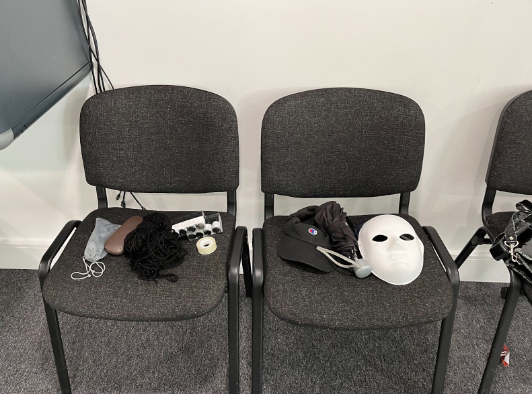
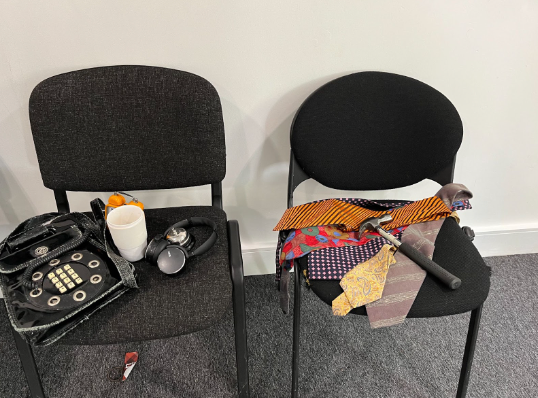
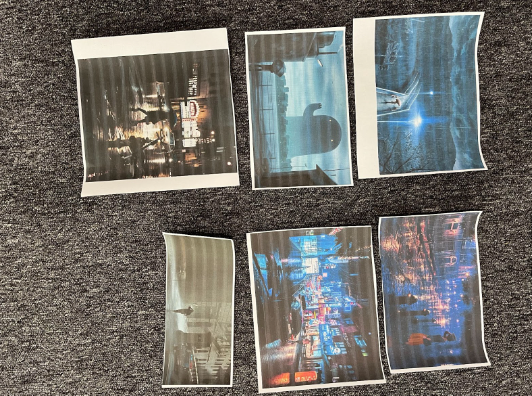
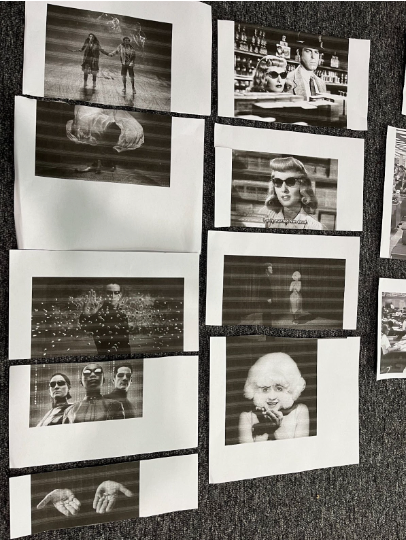

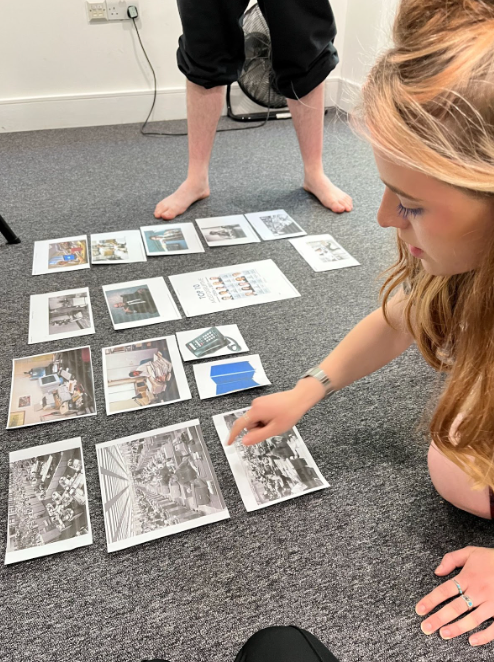
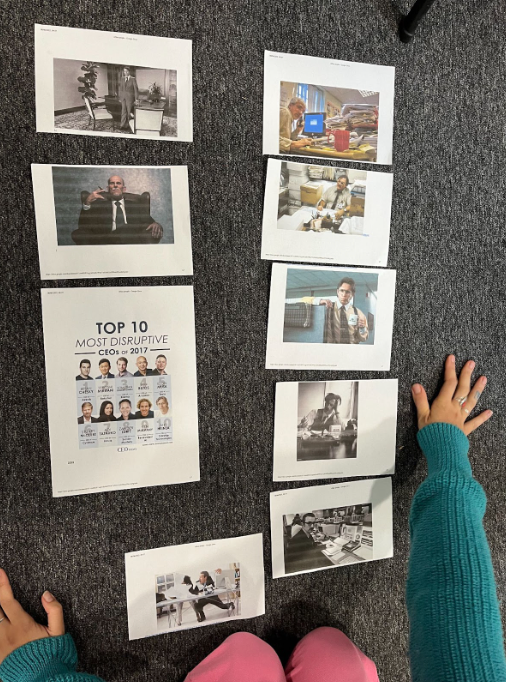
After sharing these ideas we made a mind-map and listed elements of the two worlds under categories of time, space, power, language, mood, music, social spaces and unseen spaces.
World Ideas
Domi and Hannah were sitting at a shared office desk. There was the constant sound of a phone ringing and a clock ticking. Every two minutes a buzzer would go off and Domi and Hannah would pick up a phone, spew cruel language onto the receiving end, hang up, and return to their menial work. We started to explore how far we could push this language to create an effective communication style between performers and participants that would get the point across but not alienate the participant. The hyper awareness of time and constant ringing phones were also key elements brought further and would become core elements for the soundscape of the show.
Gemma Brokis Table Exercise
We used Gemma Brokis’s Table Exercise to develop our ideas further. This improvisational exercise is based on writing a collection of prompts, which relate to the ideas and themes you would like to explore, and placing the stack at the centre of the table. There are four chairs around the table. Two people enter the space and one person picks up a prompt from which the pair has to improvise a scene. We would later add props in addition to the prompt. An example of one of these scenes was from the prompt ‘Broken Loop’. Two rain people accidentally bumped into each other, knocking them off their ‘loops’. They realise they can’t remember where they were going, where they were coming from, how long they’d been walking for, the last time they talked to someone, or their own names. They didn’t know what to do next. This scene gave us an insight into how time and perception worked in the rain world. That time almost ceased to exist. Time was not an issue for the people in the rain world, which was in contrast to the people in the office where time meant everything. The people in the rain world would live in a constant loop, not remembering when coming or going, much like in a dream, where life seems episodic. This would feed into our later investigations of what it feels like to be in a dream and how that can be translated into an immersive performance. The table exercise gave us a creative language for both worlds. Through the exercise we created an extensive amount of material to develop on and refer to later in the process.
Further Exploration of Office
We watched videos about Franz Kafka and the theory of the ‘Kafkaesque.’ With this research, we explored the characters that existed in corporate worlds further. We did a scenographic exercise where we each had 5 minutes to create a ‘kafkaesque’ scenography of the office world. We then watched clips from films such as American Psycho, Glengarry Glen Ross and Office Space to get a further sense of what kind of environments and characters we might want to create. We then combined the scenography exercise with the character exercise to create office scenes.
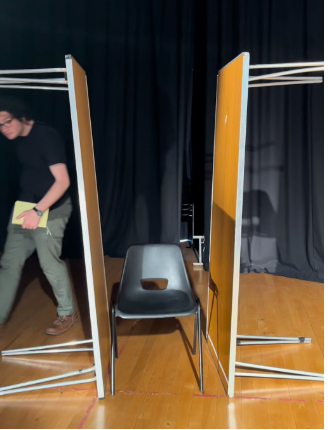


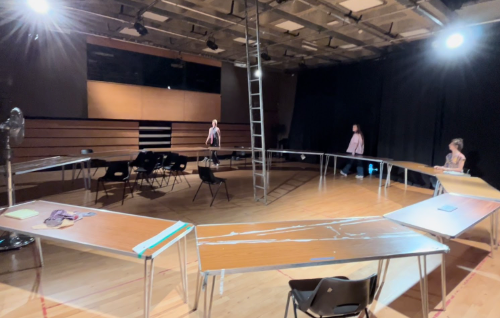

The ‘Trial Shift’ fragment was the first appearance of the character ‘Janice’, who continued into our final manifestation.
Domi wrote in response to the fragment in Jack’s rehearsal notes:
“This fragment also explored tasks and what the role of the audience may be in the environment we were creating. The participants were ‘assigned’ to the performers and asked to do their grunt work, including a series of menial tasks such as being asked to sort a pile of photos but not being given a method to sort them by, or being asked to count the number of letter As on a page of writing. ‘Meanwhile, the performers left their desks and gossipped about the trial workers and what a bad job they were doing. Eventually, a phone rang and kept ringing while Hannah yelled at Domi repeatedly to answer it (there was no phone in the room)’(Aldisert, 2022). We were discovering the idea of menial tasks with this fragment as a method of participation.” (Ucar, 2022)
The Task
In conjunction with discovering the scenography and characters of the office, we also had to figure out what their actual job was. We did an improvisation exercise, where we wrote down prompts of possible jobs the office workers could have. We would each take turns drawing a prompt and play the job recruiter for said job.
Job Recruitment Fragments
Afterwards we each had to create a task for an audience member to do that would fall under the realm of one of these jobs. Furthermore, the task would have to be menial, repetitive, and contain an element of masked violence to underpin our current dramaturgy. Domi created a task where the participants had to watch a series of videos and every time something they deemed ‘problematic’ occurred they would have to put up a post-it on a board. Hannah created a task where one participant had to write down a series of words that would be sent to them on post-its. One word per post-it. Another participant would take these post-its and sort them into four categories. The words were a mix of relevant, irrelevant and inappropriate words. We liked the tactility of these tasks, of physically having to sort the notes, much like the action of swiping left and right on your smartphone. We developed the task where the participants would each receive a pack of post-it’s with words on them that they would have to sort into two categories: productive and unproductive. The series of words also allowed us to slip in words that fell under our theme of masked violence. We would then have two characters post those notes onto a larger board marked ‘Destroy’ for unproductive words and ‘Distribute.’ for productive words. This would also give the office characters a job to do while playing out their scene. We found that it was much easier for two performers to improve a scene when they had a task to do, rather than only having the participants work. After several discussions throughout the process of the sustainability and labour surrounding writing that many post-its, this task would remain the task for the final manifestation. We couldn’t find an alternative that encapsulated the original version as well. For the final manifestation we wrote approximately 10,000 post-its.
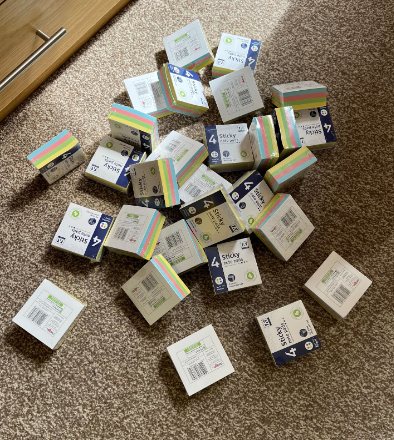
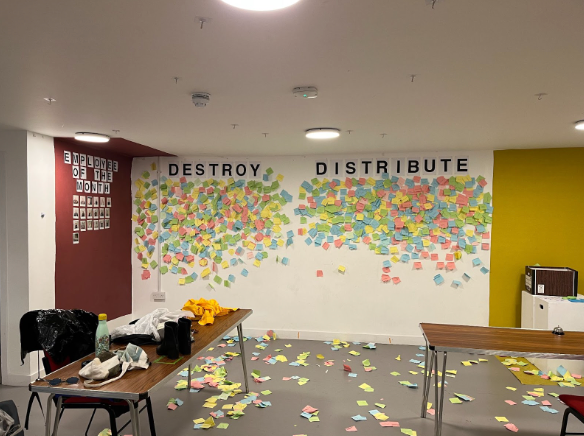
A Distant World Beyond: An Intimacy World
After having explored Office and Rain world, we felt there was something missing. We needed to figure out what the dramaturgical reason was for an audience participant to leave the office world to go to the rain world. We returned to the theory of Mark Fisher’s Capitalist Realism. We started to have a chat about the contemporary dilemmas surrounding social media and working life. Social media has made our presence a commodity in itself through data collecting and our work now expects us to take our work home with us thanks to mobile devices and the internet. Fisher put this well when he said:
Work you take home with you… working from home, homing from work. A consequence of this ‘indefinite’ mode of power is that external surveillance is succeeded by internal policing. Control only works if you are complicit with it. (2009, p. 22)
We are therefore expected to constantly produce even in our free time. The escape from the office to the rain world could represent this break away from the ‘‘indefinite’ mode of power’ we know as capitalism. The participant leaving the office could represent their rejection of being complicit in capitalist structures and the rain world could represent the alternative to capitalism. However, the way the rain world was set up seemed more like a passageway, something you had to go through to discover something else. This is where we came up with the idea of a third world: An intimacy world.
We started exploring this new world in response to the research Hannah had brought in on love and previous experimentation with proximity, sensory deprivation and touch. We had been to see a revival of Ontroerend Goed’s The Smile Off Your Face, where the audience member goes through a series of one-on-one performances while being blindfolded in a wheelchair. We liked how they used sensory deprivation to create intimacy and create imagined scenarios in your head that were later revealed to be something completely different once the blindfold came off. Much like our own experimentation with conflicting narratives, rug-pull moments and multi-sensory diegesis. We started making fragments that played with blindfolding, revelations and one-on-one interactions between audience and performer. We did this in search of a conclusion to the piece that would provide the audience participant with an intimate and personal experience in contrast to the alienating world of the office.
Cruel Optimism
In our further research on capitalism’s effect on modern life we looked into Lauren Berlant’s Cruel Optimism (2011). Berlant discusses themes around the idea of ‘the good life,’ which we had referenced to during our rehearsals and discussions of the office world. Berlant describes the cruel optimism that has prevailed since the 80s, as the receding social-democratic promise of the post-war period in the USA and Europe. People have remained attached to unachievable fantasies of “the good life”—with its promises of upward mobility, job security, political and social equality, and durable intimacy—despite evidence that late capitalist societies can no longer be counted on to provide such opportunities.
Indeed, the culture and practices of contemporary office life may actually be an obstacle to a fulfilled and flourishing existence. Here you chase something that you think is good for you or that you think will make you happier, yet the office is often designed for menial work with no obvious benefit. We illustrated this in the task set for participants, to order and organise post-it notes, which was ultimately of little consequence or usefulness.
Back to Rain World
As we were piecing together a narrative for the performance, we explored Rain World as a passageway to Intimacy World. We did the same scenographic exercise we did for the office world, where we each had 5 minutes to transform the space. All the scenographies we created had dream-like images within them - images that don’t make sense but also strangely do. We used those scenographies and added onto them the appearance of the Rain Creature. We wanted to create an eerie feeling around the Rain Creature so when it suddenly appeared, the audience would not know whether they could trust it. Taking the leap of faith to trust the creature would allow the audience member to go further into the world and eventually discover Intimacy World - a reward for going into the unknown and discovering the alternative to contemporary working life.
We explored what happens after the audience encounters the Rain Creature. We also started tailoring the different scenes to the venue in which we were going to perform. We set up a mock-Camden People’s Theatre space. Domi and Hannah started to brainstorm what weird dream-like items we could include that would be reminiscent of the Office World and thought of a water cooler, which reminded us of water fountains and wishing wells. This led us to putting a wishing well in the centre of the room as the audience entered. The rain creature eerily appeared from behind and offered the participant a coin and asked them to make a wish. We did not have any coins that day so we decided to use ties as placeholders. The creature offered the participant a blindfold, asked them to make a wish and then escorted them to Intimacy World. The intimacy person “granted” the participant the wish they had wished for in the other room, leaving the participant to wonder how the person knew what they had wished for. We knew the wish because we were secretly live recording one room and transmitting it to the other.
Jack created a scene where the participant enters the room and is immediately confronted with the rain creature. Every time the participant looked away from the rain creature, it would come closer to them. This play on ‘grandma's footsteps’ created a game where the participants had to allow themselves to be scared and look away, not knowing what would happen once the creature came close, in order to move to the next part of the piece. Once the creature approached the participant, it would gently wrap its arm around them and guide them to Intimacy World. This went along with our theme of embracing the unknown to arrive somewhere better.
Grandma's Footsteps Fragment
Combining these two fragments proved crucial to what Rain World would become. We created a fragment that first required the participant to make a wish, which then would trigger the rain creature to come alive and the game of ‘grandma's footsteps’ began. The participant would then be escorted into the mock Camden People’s Theatre elevator where they were blindfolded and led into another room. The intimacy performer would ask what they wished for and sneakily swap guiding with the rain creature. The participant was then asked a series of questions. At the end, their blindfold was removed, revealing the Intimacy person to be a different performer than expected. The intimacy performer would then sit them back in the theatre, where the person would see another participant being asked what they wished for and the guiding swap, revealing an audience of previous participants had seen what they wished for. We ran this series of events for a test audience. The general feedback was that the participants enjoyed the game aspect in the rain world, they liked being swapped over by performers without realising, and they liked being able to watch other participants go through what they had. However, they raised the ethical question of having people reveal information in front of an audience without them realising it.
Modifying Our Way of Working
Towards the end of the process we decided to revisit the way we were working. Up to this point we were mostly rotating facilitations and collectively making decisions on all elements. Once we got closer to the refining stage, we decided to talk in more detail about our individual communication styles and how we could make the decision-making process more efficient. This conversation was useful because at this point we were much more familiar with each other's style of working and we were now able to voice how we could work together in a way that accommodated each communication style.
As part of this conversation we decided to split ourselves into more specific roles. This would allow us to make the decision making process more efficient and focused. We split into different director roles: one for each of the three worlds, as well as an overall managerial/dramaturgical director who would plan rehearsals and logistics for the final manifestation.
Solidifying the Narrative
At this later stage in our process with a few weeks to go, we were still making a lot of new content and it was time to make a decision about our narrative.
After a dramaturgical session of organising post-its containing all the elements of the work so far. We organised the elements into three categories: themes, techniques and scenography. For each world we also answered answered the three questions:
What is one word that sums up everything?
What is the main question we want the participant to be asking themselves?
What is the main symbol?
We then created the outline for our final manifestation - the audience was cast as workers who have previously been working on the floor below and have just been promoted to this new floor. In this new office they are immediately given work to do which is overwhelming yet addictive. Occasionally something would ‘bleed’ into the room which hinted at the possibility of discovering an alternate world outside the office. The participant would be slipped a note, which gave them an escape route and led them into a mysterious world where they had a psychedelic experience of escape. At the end, they would interact with a character to share a moment of intimacy, only to discover that this character is also an employee of the office. The participant would discover that the psychedelic experience and intimate moment was part of the larger mechanism created to increase the productivity of the workers.
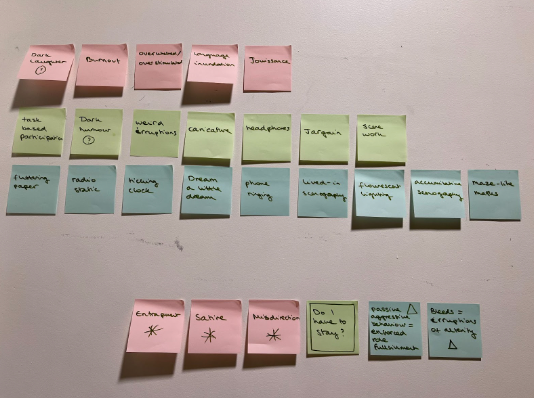
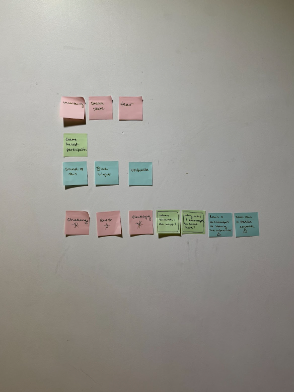
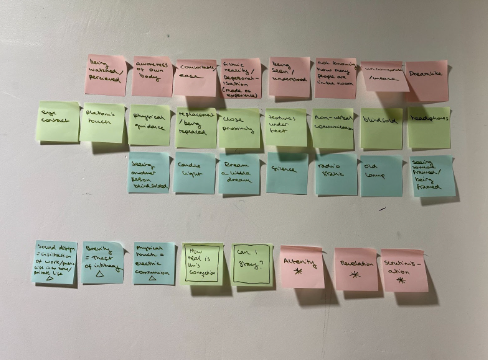
Bert and Brenda
From our explorations of setting and character in the office we had two characters emerge - Bert and Brenda. The story line we created for them was as follows:
Bert is bitter that Janice was promoted and the effect it had on the workflow in his department. He took the initiative to speak to someone upstairs about a promotion but couldn't get past the secretary. The next day he received a letter that his job is on the line and has to step in for Janice. Brenda took on Janice’s running job as well as hers for two weeks. She was upset that her friend had been promoted and she was confused how it happened. Brenda never thought about promotion before Janice’s promotion as she never had the self-confidence.
We divided the performance in the office into five different phases. In each phase Bert and Brenda each had a clear intention, which made it easier for the performers to improvise within this framework. Each phase lasted 5 minutes:
Phase 1- Bert - to engage the workers, Brenda - to make a good impression on the new workers.
Phase 2 - Bert - to motivate the workers, to sell the possibility of upwards mobility, Brenda - to probe Burt about Janice’s promotion.
Phase 3 Bert - to keep up with Brenda, to prove he is better at the work, Brenda - to impress Bert.
Phase 4 Bert - to increase productivity in the office, Brenda - to spark competition
Phase 5 Bert and Brenda - to further compete with one another and motivate the audience members.
We set out clearer events within each phase, such as the introduction that Bert delivered in phase one which gave instructions of the task, the use of the bell, the mention of Janice’s promotion and who they were. The five phases were also constructed as a technique to control the audience flow out of the office, as the performance would go from a group experience to a one-on-one experience. After each phase an audience member would be invited to leave. A challenge we found whilst improvising, was not having an audience to practise with during the rehearsal period.
Office Test Run
Janice 2.0
Since Janice no longer existed in the Office World, as played by Hannah in our interim presentation, the question became: Who is Janice? Anna and Jack’s characters Bert and Brenda would continue to refer to Janice, which gave us the idea of Hannah taking on the role of Janice who had been promoted. We decided that Janice would fill the character who resided in Intimacy World. Janice would provide an intimate experience that made her the office psychologist/ human resources. Suddenly Intimacy World was no longer a separate world but a part of the Office World. This reshaped the essence of the narrative of the show into something completely different but very exciting. Intimacy World was no longer a true intimate experience offering an alternative to capitalist working life, but rather the illusion of escape. The participant would arrive into Janice's office, be asked a series of intimate questions, only to be revealed that Janice was also an office person assessing their capabilities for a promotion. It would also be revealed that Janice was the one receiving the ‘productive’ post-its from the office in order to calculate how to make more productive employees. This kept the participants within the loop of the office, providing them no alternative to capitalist realism, but enforcing it.
After establishing Intimacy World was a construct of the higher-ups in the office, we had to strike the balance between giving the illusion of an intimate experience but remaining within the realm of a job interview/performance assessment. The participant would remain blindfolded for the question-part of the scene, giving the illusion of an intimate experience, to then be un-blindfolded and revealed that it was in fact an office. Hannah developed a series of questions that could be asked in an interview but bordered more on personal connection in an attempt to not make it too obvious that they were being assessed for a job before being un-blindfolded. Running it for a test audience revealed that the questions were in fact too subtle and did not provide enough information as to who Hannah’s character was, as the scene itself was so short. As we had learned with previous test audiences, you have to be quite obvious in immersive/participatory performance as the participants are already overstimulated by being in the piece. Hannah then developed a series of quite obvious interview style questions, but instead played with the tone of voice in which she delivered them, so they seemed more like a friendly conversation until the reveal.
What To Do with Rain Creature?
Once we decided on this narrative, we struggled to solve the challenge of what actually happens in Rain World. This was because the section was meant to create an experience which fulfilled people’s desires for the things that working life made harder to obtain, such as freedom, intimacy and quality time with loved ones. We struggled to create something that was able to capture this with our constraints of timing, space and performers. We had also had conflict between ideas that were highly visual and highly aural. We looked at the film Wings of Desire (1987) for inspiration.
Eventually, we concluded that it would be difficult to create a highly dreamlike experience that involved visuals and guiding and that using the power of imagination could be a great advantage for us. We discussed how asking an audience to imagine a fantastical journey could make the experience much more visual and fantastical than if we were to show them parts of that journey that were clearly constructed in a theatre. We also followed some previous feedback given to us about not introducing new tools and taking them away too quickly. Although this originally referred to some work we made with headphones, we realised we were also introducing blindfolds and by lifting the blindfold at certain elements too soon, we were not utilising that tool to its fullest extent.
We created two fragments in response to these challenges with the prompt: to construct a vivid image for a blindfolded audience member, incorporate film dialogue, play with genre and to explore themes of desire.
Jack and Anna started off by watching film scenes from Trainspotting, American Psycho and The Matrix. They discussed themes of Cruel Optimism, wanting to be different, simulating free time, rebellious dialogue and desire. By watching the images, instead of using the dialogue from films they used the images from The Matrix (1999):
They took the audience member on a blindfolded guided journey, leaving the office behind them and ending up on top of a roof of a concrete building. Once they had imagined the world around them they were asked to repeat dialogue in a “Repeat after me scheme” empowering the audience member and making them feel special for leaving the office.
Hannah and Domi, on the other hand, created a journey which predominantly took place in a natural environment where the participant would come across a dark lake that they would gradually walk into, adding an element of sensory imagination to the journey. Coincidentally, this fragment also included suddenly standing above the lake and trees, looking down and having the feeling of standing on the ledge of a building before flying into the night.
After creating a version that merged the most effective elements of the two, we asked Mariana Camiloti, a movement director, to come in and help us with the guiding method in Rain World. She taught us how to use breath and how to read the participant’s body language to make them feel more comfortable being guided whilst blindfolded.
Movement Directing Practice
Going From a Group Experience to a One-on-One Experience
One of the major challenges we had to figure out was how to facilitate participants going from a group experience in the Office World to a one-on-one experience in the Rain and Intimacy World. We decided that each moment between rain creature 1, rain creature 2 and Janice would last 5 minutes. This meant that every 5 minutes the performer had to pass a participant on to the next performer and receive a new participant. We are only 4 people in our company so these timings proved hard to coordinate, as we would ideally have at least two performers in the office. We therefore made the decision to invite a performer from outside the company to come help us perform. We decided that Anna and Jack would play Brenda and Bert in the office, Domi would play rain creature 2, and Hannah would play Janice. We invited Maddie Wakeling in to play rain creature 1.
Finding the correct timings between all these scenes and worlds became crucial for the loop of our show to exist. If the timing of one stage fell out of sync the whole chain would fall out of sync. Maddie, Domi and Hannah had not had time to try out the timings before the performance. We had done one test run with 7 people during a rehearsal, with Jack in Maddie’s role and in the school rehearsal rooms instead of CPT. The first group of participants going through the upstairs worlds were therefore very stressful, as we had to feel out each other's timings and how long we could take with each beat of our scenes. Each of us had a stopwatch and a strict time chart in order to maintain the continuous flow of participants.
Stop Watch Sync Practice
Rain World Hand Over Test
In the interim presentation we played with leaving secret obscure notes for the participants in the office within their post-it stacks, inviting them to leave. We wanted to give the participants a free choice about when to leave Office World and enter Rain World. However, this would be hard to coordinate in terms of the rest of the show being a one-on-one performance. We had to have a controlled exit of participants from the office to make that work, which eliminated the element of choice. We could, however, still play with the illusion/theme of free choice. During our interim presentation we learned that we needed to be quite obvious about what we wanted the participants to do and at what time. We therefore decided that the character of Brenda would directly hand a note to the participant we wanted to leave, that explicitly stated when and where to leave. If they did not leave we would gently escort them. This was a bit more controlled and forced than we would have liked, but due to the limited number of performers and timings we had set up we needed a controlled and consistent flow of people.
Note given to audience
Flowing and Looping: The Full Performance in Camden People’s Theatre
We had to situate the different worlds in the different rooms of the theatre so it would create a logical flow between scenes, while allowing the rug-pull moment at the end to take place. In addition to revealing Janice as an office worker, we expanded the rug-pull moment to include the participant seeing other participants going through Rain World on their way out. This was in response to the feedback of our test audience who said they had enjoyed watching other people go through what they had experienced, suddenly getting a new perspective on it. This reveal also enforced our dramaturgy of showing the participant that they were just one of many. It may have felt like we were giving them a customised experience, that they were special, but in fact we performed the exact same sequence of events on a loop. Furthermore, they thought they had escaped the menial work downstairs but in fact were now just being promoted to do other menial work, just with a fancier title. By letting the participant be privy to this information we made them complicit in the structures of our office, which is why they got the promotion. This type of reveal, thinking you are unique but are in fact one of many, was heavily inspired by Ontroerend Goed’s Smile Off Your Face.
The office world took place in the basement. The design took reference from the collective inspiration pictures from the office people and space.We looked into colour blocking and created a mid-century colour palette. Colour blocking is believed to originate from Piet Mondrian but became popular in the 1960’s through fashion and interior design. Usually colour blocking would be painted onto walls but with the minimal get in/out time we looked at other alternatives. We decided on using large strips of fabric from our colour palette, wallpapered on with a diy solution of cornstarch and water to create a wallpaper paste which is easily removable with water. The colour blocking helped to transform the white walled basement room into an office space with a mid-century twist. The colour blocking helped to distinguish different areas of the space such as ‘Burts office’ which was framed by teal fabric on the walls and floor. A desk and stacked office boxes to create a lived in office that is referenced in Berts introduction. For our interim presentation we created a desk configuration that has them perpendicular to each other, instead of neat rows. This created a balance between isolation and community between the audience members. This design and techniques helped us fulfil one of our project aims, which was to create an adaptable scenography, which would allow us to transform a variety of performance spaces into our worlds.

Office Basement Design Sketch

Bert Costume Drawing
To enter the rain world we had the participant exit through the back door of the basement. They would enter a dark room lit by dark blue light with the sound of rain. The only way forward was to go up a flight of stairs. At the top they would be met by Rain Creature 1, who blocked the path to further entry. In front of the creature was a glass box filled with ties with a text prompting them to make a wish. Once the wish was made, they would be handed a sleep mask, and the blindfolded guiding would begin. Once blindfolded we did not have to hide the mechanisms of our performance, as the participant would not be visually privy to them. Having obvious mechanisms out in the space would help enforce the reveal at the end when Janice escorts the un-blindfolded participant through.
Once blindfolded, the participant was taken through a doorway with strips of fabric attached which would brush against them to create a multi-sensory diegetic experience of rain pouring over their body. It would also mark their transition into a new space; a new world. Rain Creature 1 would place the participant to stand still and use two speakers to play “Dream a little Dream” backwards on one and Delta Sound Waves on the other. The audience member would be prompted to let their body sway. We saw this moment in the piece as a hypnotic, priming to lead into the subsequent rain sequence in the theatre. The hypnosis would end with a countdown, from where Rain Creature 2 would take over the guiding. Rain Creature 2 would bring them into the theatre where they would walk around with the participant while playing a recording of the dream-journey we wrote. We chose to make this an audio so the performer only had to focus on guiding the participants safely.
The second rain creature would walk back into the hallway and place the participant into the dressing room, which functioned as Janice’s office. Janice would sit next to them and ask them three questions and then finally ask to un-blindfold themselves. When the participant took off the sleeping mask it would be revealed that they were in an office space. A wall was covered in ‘productive’ post-its from the office below. The room would only be lit by a weird ornamental desk lamp, which shone a warm light to make the room seem more intimate. This was to strike the balance between office and intimacy. The design made it purposefully unclear which time period it was in, in contrast to the very clear late-mid century theme of the office below. Almost as if the participant had travelled in time to arrive at this new office space. Janice would then take the participant out of the dressing room through the hallway, where they would witness Rain Creature 1 with a participant to the left and Rain Creature 2 with a different participant to the right. They would then be led to the bar area of the theatre where they would receive the final words of the show. Janice would reenter the hallway, leaving the participant back out in the real world.
The pathway the audience member had to follow ended up fitting very nicely with the dramaturgy of the piece. The fact that the dressing room was located between the two rain creatures situated Janice’s office perfectly in the rain world, as part of the office construct. It would also give a clear view of Rain Creature 1 and Rain Creature 2 for the final reveal. As we had never run the performance in full before, Hannah was uncertain as to how long she should let the participant watch the two blindfolded participants in the Rain World and exactly which part they should watch. After having run the performance for a while, she started to learn the timings of Domi and Maddie and when each participant would be at certain points in the rain scenes. She found a perfect timing point. When she could hear the participant leaving the office below, as the door slammed behind them, she knew she had to have the participant in Janice's office write the blue letter. This would time them so when she brought them out of her office they would see the participant in rain world two repeat the affirmation and then the participant in rain world one go through the curtain. These two moments strongly revealed the artifice of our creation and tied the end of the performance up perfectly. Having the participants see these revealing moments of participation, they themselves had gone through, reinforced the imagery of the constant loop that our world functioned on. Hopefully the participants would link this loop to the idea of the inescapability of capitalist realism they experienced in the office basement.
From the Beginning to the End: How Did the CPT Performance Reflect Our Original Project Proposal
Our proposed activity was to create a darkly humorous interactive performance with the aim of making its dramaturgy inextricable from the technicalities of audience participation and offering an experience that destabilised reality and offered a mystical psychedelic experience. When we first set out these aims for ourselves, it seemed like an overwhelming task. The different elements of dark humour, audience participation and psychedelic experience seemed hard to reconcile into one project. But looking at the work we put on in Camden People’s Theatre we did manage to do just that.
The show was darkly humorous, as it played with social norms in the workplace through comedic characters and tasks. The narrative we constructed can even be seen as one long dark joke. We set up the possibility of an alternative life outside or constructed office, but then end up giving a promotion for taking initiative to escape the grunt work.
We created a performance that was inextricable from the audience’s own participation. We cast each audience member as the protagonist of the show and the narrative was shaped around their journey through the piece. The audience members did not have any real agency over the story as the core structure was decided for them and their individual participation would not alter the final outcome of the story. Yet without the audience there would be no performance–our characters would have no one to talk to and act upon to fulfil their ambitions.
We managed to create a psychedelic experience in the “Rain World” when Rain Creature 1 ‘hypnotises’ the participant as a priming technique to go into a new world. Playing the song “Dream a Little Dream” backwards and also Delta Sound Waves from separate speakers, created a pre-psychedelic effect: the sensation of the psychedelic entering and overtaking your system. The journey the participant went on with Rain Creature 2 was psychedelic itself. The participant is asked to imagine surreal scenarios, as they are blindfolded, as if in a psychedelic induced dream-state. “Rain World”, with its psychedelic experience, was one aspect of our attempt to destabilise reality–the other was the whole performance itself. The participant is always unsure which World they exist in– or something completely fantastical. And the rug-pull moment at the end, where the participant is invited to question the whole journey of the show and their part in it, offers a perplexing and thoughtful climax.
We also set out to create an adaptable scenography that would allow us to travel with the show, hence not making it site-specific, and easily adaptable. The techniques Anna developed around the design elements of the show allowed us to put up scenography to create three distinct Worlds in less than 4 hours. The heavy use of blindfolding and dramatic lighting also puts less demand on whatever space we are using for “Rain” and “Intimacy World”.
We asked ourselves four questions at the start of the process–and we continued to do this as the project progressed:
What is immersive theatre and how do you make it? What we found helpful when creating a devised piece of immersive theatre, was creating fragments in pairs and then using each other as participants. This way we could see aspects of the work with an external eye, as we weren’t privy to the creation of the other’s fragment. This way we could also generate more ideas and curate elements from a larger pool.
What is the place of discomfort in interactive theatre? We played with different kinds of participation and the boundaries and ethics concerned with each of them. “Office World” was supposed to be an unpleasant place, but we did not want the participation to disengage the audience because they felt their boundaries were crossed. We therefore played around with the language we could use with participants–and how much physical engagement was necessary. We also experimented with levels of participation as we gauged, through test audiences, that people are more likely to engage once they feel immersed and know the general rules for participation. The place of discomfort in immersive theatre seems to be the balance between the unknown, the required participation and the type of world they are asked to participate in. Discomfort need not be a negative thing if it is productive discomfort– a theatre maker can use this discomfort to prompt the participant to reflect on certain topics, themes and human behaviours. Perhaps you need to be uncomfortable in order to see something from a different perspective or something outside your comfort zone. Indeed discomfort may prompt participants to reflect on why the creators chose to put them in a situation– and in a good immersive show the audience will learn why.
What is the place of destabilising humour in interactive theatre? Humour can be a good way to introduce your participants into the immersive piece. It can serve to break the ice and make the participants more comfortable. Humour can also be used to destabilise the interaction or scenario. This is a distinct quality of dark humour which plays with the absurdity, contradictions, and faults of the society we live in. It is especially when it plays with faults that it can start to destabilise– dark humour can shine a new perspective and offer an alternative view of society. Also using dark humour, as a tool in immersive theatre, has similar effects to using discomfort. It can make the participant question why they are laughing in a scenario that is, at its core, a tragedy. Unlike discomfort, dark humour has the added element of fun and we used a lot of dark humour in our piece exactly because of this element. The fun was meant to disguise the much darker themes hidden below. We also used humour as a ruse to seduce the audience into being more complicit.
How can the betrayal of trust be used as a tool in interactive theatre? Our experimentation with trust and the betrayal of participants manifested itself in “rug-pull” moments. We even named one of our techniques a “Brechtian rug-pull”, which referred to a reveal from one strange world to another. However, to use it as a tool, the rug-pull moment must help further the narrative rather than be just a spectacle. In our first experimentation with the “Brechtian rug-pull”, for our first sharing, it was used mostly for spectacle and playing with multiple and multisensory narratives. The way we continued to play with it was more in the style of Ontroerend Goed: we wanted to use the reveal to expose the larger narrative of the show which the participants hadn’t been privy to before the end. The participants thought we were telling them one story, when we in fact were telling them another. The betrayal lies not only in the deception but making the participant the central pawn in its construction. We used this betrayal of trust as a tool to underline the main theme of our narrative: the inescapable capitalist construct. We betrayed the participant in the same way capitalism portrays the modern person: capitalism promises freedom of choice, and tells the individual that they are special, as a disguise to ensure its continued growth.
These are very broad questions and the answers can be different things depending on the company and the performance. We found some answers to these questions at the end of our process but, as theatre is a living and constantly evolving work of art, we still consider this piece to be a work-in-process and these answers will change and grow. The project is centred around the immersion and participation of its audience and will therefore change and grow with each new live encounter.
Bibliography
Aldisert, J. & Ucar, D. 2022. SIP Rehearsal Notes. Unpublished
American Psycho. 2000. [film] Directed by M. Harron. Toronto and New York City: Lionsgate.
Barker, H., 2016. Arguments for a Theatre. 2nd ed. London: Oberon Books Ltd.
Bergson, H., 1900. Laughter: An Essay on the Meaning of the Comic in: Higgie, J. (ed.), 2007. The Artist's Joke. London: Whitechapel.
Berlant, L., 2012. Cruel optimism. Durham, NC: Duke University Press.
Berlau: Königreigh Der Geister. Kittstein, L. (2022) Directed by Mikeska, B. [Berliner Ensemble, Berlin, June 2022]
Collective Encounters. n.d. 1990's -Participatory Theatre. [online] Available at: <https://collective-encounters.org.uk/centre-for-excellence/participatory-theatre-timeline/1990s-participatory-theatre/> [Accessed 6 September 2022].
Command and Control. 2016. [Documentary] Directed by R. Kenner. USA: American Experience Films.
Cucumber Man, Guardian of the Spa, the Most Refreshed. n.d. Found at: https://9gag.com/gag/ang0zWz
Fisher, M., 2009. Capitalist Realism: Is There No Alternative?. Winchester: Zero Books.
Gintberg Dees, H. 2022. SIP Rehearsal Journal. Unpublished
Glengarry Glen Ross. 1992. [film] Directed by J. Foley. New York: Zupnik Enterprises.
Gorman, A. 2022. SIP Rehearsal Journal. Unpublished
Higgie, J. (ed.), 2007. The Artist's Joke. London: Whitechapel.
Ibrahim, S., 2022. Two Palestinians Go Dogging. London: Nick Hern Books.
Kantor, J., Barbaro, M., The New York Times, 2022. The Rise of Workplace Surveillance. [podcast] The Daily. Available at: <https://www.nytimes.com/2022/08/24/podcasts/the-daily/workplace-surveillance-productivity-tracking.html?> [Accessed 31 August 2022].
Kelley, M., 1989. Foul Perfection: Notes on Caricature in: Higgie, J. (ed.), 2007. The Artist's Joke. London: Whitechapel.
Marvin, R., 2022. The Best Employee Monitoring Software for 2022. [online] PCMag UK. Available at: <https://uk.pcmag.com/cloud-services/92098/the-best-employee-monitoring-software> [Accessed 31 August 2022].
Mogilnitskiy, P., 2022. Directing and Performing Class at Royal Central School of Speech and Drama.
Office Space. 1999. [film] Directed by M. Judge. USA: Judgemental Films.
Ridout, N., 2006. Stage Fright, Animals, and Other Theatrical Problems. Cambridge: Cambridge University Press.
Royal Court. 2022. Two Palestinians Go Dogging. [online] Available at: <https://royalcourttheatre.com/whats-on/twopalestinians/> [Accessed 7 September 2022].
The Smile Off Your Face. Ontroerend Goed. 2022. Originally directed by Sophie De Somere and Joeri Smet, Coached by Charlotte De Bruyne, Aurélie Lannoy. [De Brakke Grond, Amsterdam, June 11]
Ucar, D. 2022. SIP Rehearsal Journal. Unpublished
Veep. 2012-2019. [Television Series] Created by A. Iannucci. Baltimore: HBO.
Warren, J., 2017. Creating Worlds: How to Make Immersive Theatre. London: Nick Hern Books.
Weitz, E., 2016. Theatre & Laughter. London: Methuen Drama.
White, G., 2013. Audience Participation in Theatre: Aesthetics of the Invitation. London: Palgrave Macmillan.
Wikipedia. n.d. Participatory Theatre. [online] Available at: <https://en.wikipedia.org/wiki/Participatory_theatre> [Accessed 6 September 2022].
Wikipedia.org. n.d. There is no Alternative. [online] Available at: <https://en.wikipedia.org/wiki/There_is_no_alternative#:~:text=%22There%20is%20no%20alternative%22%20(,British%20prime%20minister%20Margaret%20Thatcher.> [Accessed 30 August 2022].
